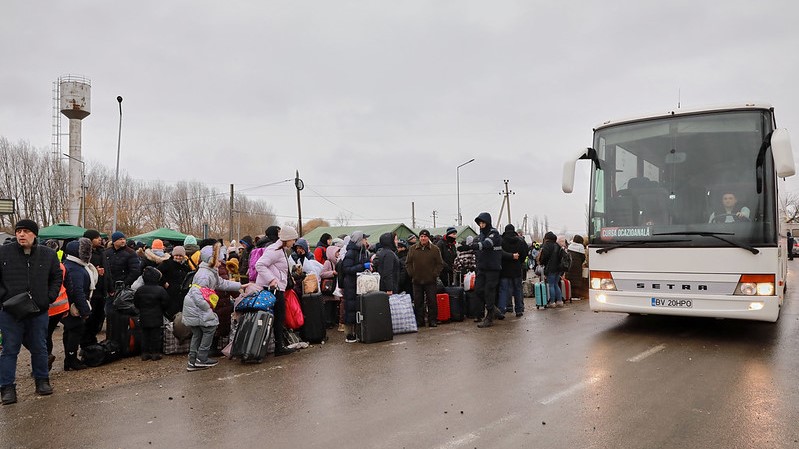Refugees and migrants are heading in multiple directions and criss-crossing South America. More and more Ecuadorians are fleeing their country, with many crossing the Darien Gap, which poses extreme risks. As the flows increase, so does the need for more coordinated actions to respond to refugees’ and migrants’ needs during their journey, Cristina Escobar (LSE) and Geoff Goodwin (University of Leeds) explain.
Colombia is on the front line of two Latin American migration crises. The first, which has received considerable media and policy attention, has seen millions of Venezuelans travel through or move to Colombia since the collapse of the Venezuelan economy in 2015. The second crisis, which has gone largely unnoticed, is the growing number of Ecuadorian refugees and migrants who have travelled through Colombia on their way to the US following a surge in poverty and violence in Ecuador since 2017.
The political and ideological context in which these two crises have emerged could hardly be more different. Whereas the Venezuelan crisis has taken place in the context of a state-centric left-wing project overseen by Hugo Chavez and Nicolas Maduro, the Ecuadorian migrant crisis has been triggered by a right-wing neoliberal project led by Lenin Moreno and Guillermo Lasso, with the enthusiastic support of the International Monetary Fund (IMF).
Poverty, fear, and despair in Ecuador
The socioeconomic slump in Ecuador has not been on the same magnitude as the collapse in Venezuela, one of the steepest in Latin American history. Yet neoliberal restructuring and austerity have had a devastating impact in Ecuador. Public spending cuts have decimated public services and infrastructure and increased precarity and poverty. One in four Ecuadorians live on less than $88 a month – the national poverty line – while many more have insufficient funds to cover their basic needs (estimated at $767 per month for a family of four).
Violence and insecurity have surged, especially in the coastal region, where street gangs and international criminal networks vie for control of lucrative drug trafficking routes. Prison revolts and outbreaks have become common place and hundreds of prisoners have been killed in jail since Lenin Moreno opted for the path of neoliberal austerity in 2017.
Poverty, fear, and despair have encouraged more and more Ecuadorians to flee the country, especially since the easing of Covid-19 restrictions. According to the Instituto Nacional de Estdísticas y Censos, net migration jumped to 81,758 in 2021, the highest annual rate since 2003, while Banco Central de Ecuador data indicate remittances from abroad rose to nearly $4.5 billion in 2021, a record amount. There has been a persistent increase in migration since then, with growing evidence of increasing numbers of Ecuadorian migrants travelling overland to the US.
Treacherous routes via the Darien Gap
Ecuadorians, along with refugees and migrants from other nationalities, head toward the US via Colombia, facing multiple challenges along the way. First, they cross the border from Ecuador to Colombia, head towards Cali by the Pan-American highway, and then to Medellín. From Medellín, they depart to Necoclí, a coastal town located in the Gulf of Urabá in the subregion of Antioquia. After resting in Necoclí, they take a ferry and ride to Acandí, a seaside village situated on the border with Panama. In Acandí, they start their journey to cross the Darien Gap, lasting between seven and ten days walking approximately 100 kilometres. Walking is the only way to travel because the dense jungle and mountainous terrain interrupts the road connection between South America and Central America.
After crossing the Darien Gap, refugees and migrants arrive at Bajo Chiquito, a small town located in Panama, before continuing overland or by boat to the US. Most migrants remain in the US, if they make it that far, while some others travel on to Canada, where there is a growing Ecuadorian diaspora.
During their transit, refugees and migrants face different protection and life-threatening risks. According to the Mixed Migration Centre (2022), from data collected during July and September 2022, surveyed women and men, refugees, and migrants reported abuses and dangers experienced in the journey through the Darien Gap. They suffered from injuries, illnesses and health problems from the harsh conditions of their journey. Additionally, they have reported Robbery, physical and non-physical violence witnessed death, sexual violence, along with bribery and extortion.
These risks are common in any irregular transit. In the Darien Gap, however, the hazards increase because of the extreme natural conditions, including rainforest jungles with steep mountains and vast swamps with temperatures of 35c (95F) and high humidity. The lack of state presence and the pervasiveness of criminal groups who control the transit of refugees and migrants heightens risks during transit.
Despite these dangers, thousands of Ecuadorians are prepared to risk the crossing. One Ecuadorian told the Spanish newspaper, El Pais, “Tengo mas miedo de vivir en Ecuador que de cruzar el Darién” (I have more fear living in Ecuador than crossing the Darién) – indicating just how precarious life has become in Ecuador.
According to official data from the Panamanian government, in 2022, 248,284 refugees and migrants entered Panama irregularly through the Darien Gap. 150,327 were Venezuelans, 29,356 were Ecuadorians, followed by 22,435 Haitians. During January 2023 alone, 6,352 Ecuadorians entered Panama compared to 100 in January 2022. This increase is related to the fact that since September 2021, countries such as Mexico have required a visa for Ecuadorians to enter their country, restricting access to the many Ecuadorians who flew to Mexico to attempt to cross the US border.
Shifting patterns of Venezuelan migration
Although Venezuelan refugees and migrants remain the dominant group crossing into Panama, some have returned home, either permanently or temporarily, and Venezuelan migration patterns are changing. According to the United Nations High Commissioner for Refugees (UNHCR) Representative in Ecuador, Venezuelan flows are becoming more complex, and there are refugee and migrant flows heading in multiple directions, criss-crossing South America. For example, some Venezuelans are leaving Ecuador for Chile via Peru, others are moving internally in Ecuador looking for new opportunities, while others are travelling from Ecuador to Colombia. Declining numbers of Venezuelan children enrolling in Ecuadorian schools is just one indication that increasing numbers of Venezuelan migrants have decided to leave Ecuador because of the crisis. Those who go to Colombia, often return to Venezuela for a couple of weeks or months (pendular movements) to visit family or to do administrative paperwork before heading to the US.
Humanitarian responses and state neglect
Migration flows have overloaded the Colombian government’s response capacity. Refugees and migrants in transit are passing through small municipalities such as Necoclí and Acandí, where services for host communities are already limited. UN agencies, national and international NGOs, and the International Committee of the Red Cross (ICRC) have been vital in providing humanitarian aid such as shelter and food, mental health and psychological support, case management for gender-based violence survivors, child protection, and legal protection services, among other relevant services.
The Interagency Group for Mixed Migration Flows (GIFMM in its Spanish acronym) is a group of UN Agencies, international and local NGOs, and ICRC created at the end of 2016 to respond to the increasing flow of people arriving from Venezuela. The group coordinates the national response to Venezuelan refugees and migrants, Colombian returnees, and host communities in Colombia, complementing the response of the government. This structure is part of the Regional Inter-Agency Coordination Platform, coordinating the response across 17 Latin American and Caribbean countries.
These mechanisms have enabled a better-organised response between nations and organisations. However, as refugees and migrants continue to cross the Darien Gap, more coordinated actions are needed to respond to refugees’ and migrants’ needs during their journey, including collaboration between the various countries that they travel through on their way to the US.
The recent catastrophic fire at a migrant detention centre in Ciudad Juárez in Mexico, which left at least 40 people dead, shows that urgent infrastructure investment is also required to protect and support migrants and refugees in Latin America. Stricter US migration laws are shifting the responsibility of caring for migrants and refugees to Latin American countries, putting them under even more strain as they attempt to recover from devasting effects of the Covid-19 pandemic.
Confronting historical and structural factors
While better humanitarian and infrastructural support is vital, shifting patterns of migration in Latin America are expressions of political-economic crises that are rooted in long-term processes of colonial-capitalist development and the positions Latin American countries occupy in the capitalist world economy. The contrasting cases of Ecuador and Venezuela indicate the complexity of attempting to confront these processes and structures. Until the roots of inequality, poverty, and violence in Latin America are addressed, migration will remain a vital survival strategy for the millions of Latin Americans who have little option but to risk everything to attempt to find a better life in a distant land.
This post was originally published on the LSE Latin America and Caribbean Centre (LACC) Blog. The views expressed in this post are those of the authors and do not reflect those of the International Development LSE blog or the London School of Economics and Political Science.
Image credit: People walking out of a metro station in Medellin (Colombia). / David Bautista (Shutterstock).





